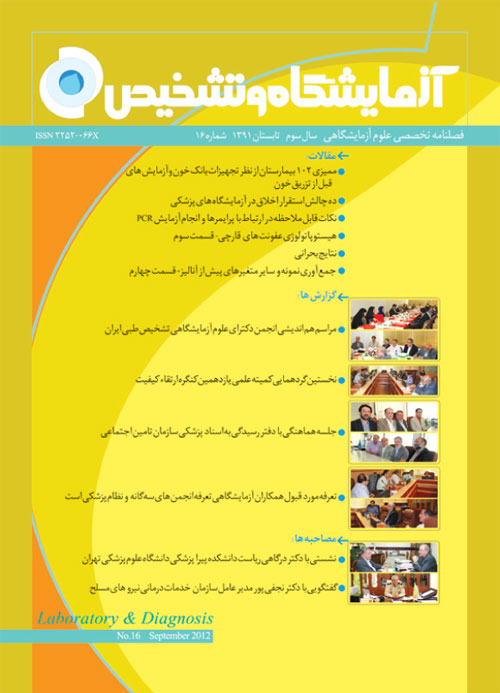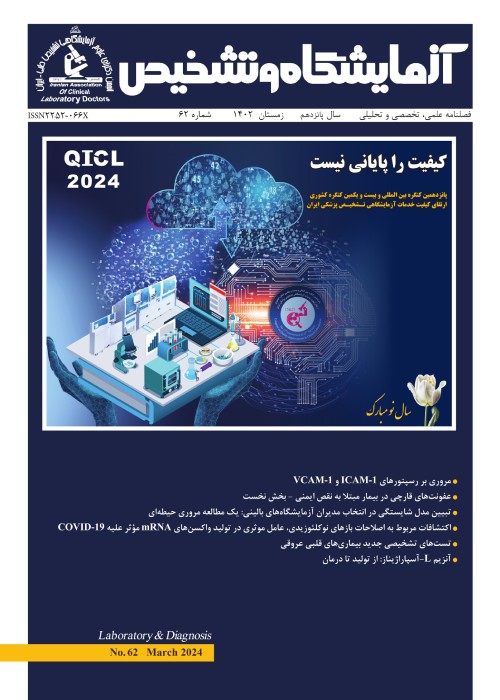فهرست مطالب

فصلنامه آزمایشگاه و تشخیص
پیاپی 16 (تابستان 1391)
- بهای روی جلد: 20,000ريال
- تاریخ انتشار: 1391/06/20
- تعداد عناوین: 14
- سخنی با همراهان
-
صفحه 4
-
صفحه 22
-
صفحه 31
-
صفحه 91
-
Page 7Background Blood banks are connection site between blood centers and hospitals. Blood transfusion organization emphasizes on applying SOPs, using and calibrating of blood bank equipments and preventive measures for probable risks and mistakes. To evaluate the practices and blood banks equipments, the present study was designed. Methods & Materials In two separate domains including practices and equipments, 102 hospital blood banks, were evaluated. Blood banks were categorized in three groups based on scoring method. Data were analyzed by SPSS version 19.5 using descriptive statistics. Results 31% of hospitals had independent space for blood banks, however, the rest had to share with another part of labs.In equipment domain of the study, it was found that 88% hospitals had serofuge,63% had separated water bath for throwing plasma,67% had blood banking refrigerator, 42% had plasma freezer and 22% had platelet shaker Incubator. In practice domain it was revealed that 88% of hospitals had SOPs, 82% meet standard practice for cross match and just 8% did antibody screening. Conclusions Majority of hospitals (70%) were categorized in good and acceptable condition for transfusion related practice and equipment. This finding could be introduced education and repeatedly audits.
-
Page 12The priority of providing welfare,health and patients’ interests is ageneral principle in medical ethics. The medical laboratory services should be presentedregarding the ethical principles. This study is aimed to describe a clear picture of the present status of medical ethics in medical laboratories and the challenges related to the establishment of them. In order to achieve this goal, the following three research questions were addressed in this study: 1- Are the criteria concerning the medical ethics in medical laboratories regarded for the patients refer to medical laboratories appropriate in terms of the theoretical and practical considerations including real tariffs for medical laboratory services, professional competitions amid medical laboratories, financial relationships between physicians and the heads of the medical laboratories, financial commitments of the insurers, the quality of the kits and the other utilized materials, and validity or accuracy of the tests from the viewpoints of the patients and of the heads of the medical laboratories participated in the study? 2- What are the overall impressions of the patients and of the heads of the medical laboratories regarding the present status of administration of the medical ethics in the medical laboratories? 3- Is there any significant difference between the patients’ viewpoints and those of the heads of the medical laboratories? A quantitative design inclusive the questionnaire was utilized to carry out the present research. The questionnaire contained 10 criteria for fundamental challenges relating to establishing the medical ethics in medical laboratories. One hundred patients and thirty head medical laboratory, as available samples, participated in this study. The results demonstrate that the patients and the head medical laboratories were not satisfied with the present status for most of the criteria which the medical ethics should fulfill. Moreover, the results show no significant difference between the viewpoints of the patients and the head medical laboratories. Despite, the overall impressions of the participants reveal that they are satisfied with the present status of administration of medical ethics, it seems essential that the improvement in establishing the medical ethics is given peculiar consideration by providing the solutions to the challenges examined in the study.Keywords: Medical Ethics, Medical Laboratory, Challenges
-
Page 18Obviously PCR methods should have been optimized before being applied in diagnostic laboratory. It is observe that occasionally precise evaluation of used PCR protocols especially in home brew tests are not being considered therefore can cause problem in reliability of them. Evalution of the test with clinical specimens also should be considered to ensure of highest efficiency. Therefore having experiments with all know types of the infectious agents is quite necessary. Also diagnosis of the infectious agent in all required specimens with reasonable number of tested specimens enables us to be ensured of the provided results. Besides, those tests practically will be achieved that has been confirmed by frequent researches. In this review we are going to explain about primer designing and PCR processes.
-
Page 22Histoplasmosis- The spectrum of histopathologic findings ranges from localized granuloma formation to massive aggregates of macrophages containing aboundant numbers of yeast cells with absence of granuloma formation. PMN’s are rarely seen in histologic or cytologic preparations from histoplasmosis unless there is massive necrosis or bacterial superinfection. Early pulmonary lesions are characterized by aggregates of histocytes within alveolar spaces. During tha acute stage, lymphohematogenous dissemination is common. The histologic appearance of yeast cells of H. capsulatum can be confused with Penicillium mareffei, also may be confused with intracellular amastigotes of Leishmania spp. And Trypanozoma cruzi. Coccidioidomycosis- Inhaled arthroconidia enlarged and round up to form thickwalled, immature spherules that measure 5-30 micrones in diameter in the lungs. Mature spherules are 30-100 micron in diameter filled with 2-5 micron diameter endospores. Neutrophilic inflammatory reaction is seen predominantly around newly released endospores. Blastomycosis- In tissue, yeast cells of Blastomyces dermatitidis are most likely to be 98 16- شماره 1391فصلنامه آزمایشگاه و تشخیص- تیرconfused with immature spherules of C. immitis or with P. brasiliensis. Capsule deficient forms of C. neoformans can be differentiated on the basis of melanin staining. Although the width of the bud attachment is the most useful diagnostic criterion for diagnosis of B. dermatitidis, budding is not always present. Paracoccidioidomycosis- Paracoccidioides brasiliensis must be suspected in granulomatous or mixed granulomatous- suppurative disease of the lung or mucous membranes in patients from endemic parts of south and central America. The only pathognomonic feature of P. brasiliensis is the presence of peripheral budding. Sporotrichosis- Primary pulmonary sporotrichosis is less frequent, occurring mostly in men with alcoholism or chronic pulmonary disease. Primary pulmonary sporotrichosis may present as a solitary mass-like lesion, fibrocaseous granulomatous disease with cavitation or in a military pattern. S. schenkii is a globose, oval or “cigar shaped” yeast, 2-6 micron in diameter, but occasionally up to 10 micron.
-
Page 31Critical Values in medical laboratory management, became an important job; since lundberg, G. D. publication in 1972. These are patient's results that if left untreated, will be life threatening for the patient. The university of Virgina defined, critical values as: Those results that have a potential life threatening significance in the diagnosis, treatment and management of the patient.


